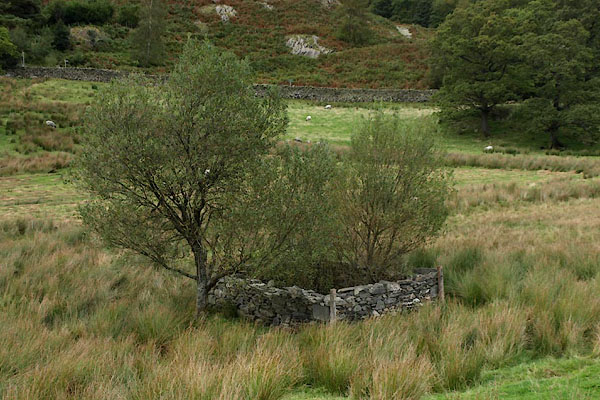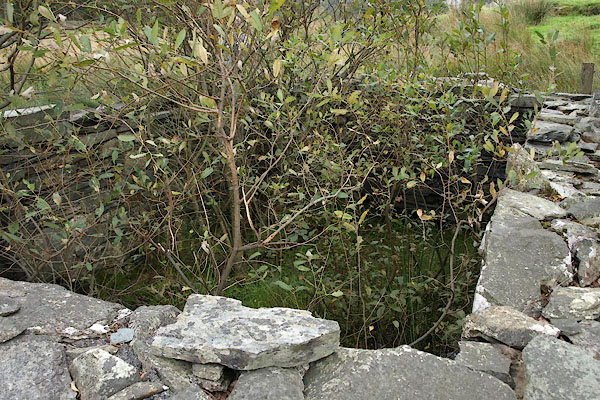





BRP51.jpg (taken 25.9.2009)

BRP53.jpg (taken 25.9.2009)
placename:- Salt Well
 goto source
goto sourcePage 94:- "... The Grange was the place where they laid up their [monks of Furness] grain and their tithe, and also the salt they made at the salt spring, of which works there are still some vestiges remaining, below Grange."
"..."
 goto source
goto sourcePage 114:- "[Mr Pennant's description] ..."
"'... Borrowdale ... a salt-spring, once the property of the monks of Furness, trickles along the shore; ..."

CT2NY21N.jpg
"Salt Spring / Mr. Banks's"
item:- Armitt Library : 1959.191.3
Image © see bottom of page
placename:- Borrowdale Well
item:- cutaneous eruptions; rheumatism; gale
 goto source
goto sourcePage 83:- "... Below this house [Manesty] is Borrowdale-well, a medical water of excellent quality, and was formerly much frequented; it is a never failing cure for cutaneous eruptions in man or beast, by washing only. I attended it several years, (but not of late) on account of rheumatic pains in my left shoulder, about mid-summer, five or six years successively: It so cured me that I have not had the slightest touch of it these twelve years past."
"The water is strongly saline, but the want of convenience for lodgers makes it little frequented. It rises out of a dead flat through a spar-rock adjoining to a peat-moss, whereon grows the plant called Gale, which curious plant is found on almost every moss in this country."
"The water tastes very like sea-water, is very clear and pellucid; but a kind of moss seems to arise with it, and remain upon the top like a scum. I could wish that some of our medical Gentlemen, who are not employed in inventing or defending useless theories, would describe its qualities; I cannot, as it is out of my line. I therefore speak only what I have seen and experienced."
placename:- Spaw Well
placename:- Borrowdale Well

CL152518.jpg
"SPAW or BORROWDALE WELL"
building?
item:- private collection : 169
Image © see bottom of page
item:- geology
 goto source
goto sourcePage 154:- "... A salt spring near the Grange in Borrowdale, has anciently been in some repute for its medicinal qualities; another has been more recently discovered in working a lead mine near Derwent Lake. They both issue from veins in this rock, but their source remains unknown."
item:- spa
 goto source
goto sourcepage 83:- "..."
"The water which springs in the northern end of the mine [Brandlehow] was formerly largely impregnated with salt, and it has occasionally been used medicinally. The amount of salt and other minerals in the water is now much less than formerly."
"The following analysis of the water is copied from a paper by Thomas Ransome, Esq., in 1848. Man. Lit. and Phil. Soc., Ser.2, Vol.8, p.399."
The solid contents are contained in the following proportions in the imperial pint:-
Or in 1,000 parts by weight - ""The peculiarity of this water is the large quantity of chloride of calcium which it contains. The largest amount recorded in any analysis I have been able to find is in one of the saline springs at"
 goto source
goto sourcepage 84:- "Leamington, which contains 28 grains in the pint, or not quite one-third of the quantity in the Brandley spring; but the deficiencies of sulphate of magnesia and soda prevent it being used for the same purposes as those celebrated springs.""
"..."
 goto source
goto sourcepage 108:- "... At a short distance from this vein [Brandley Vein], on the western side, apparently connected with the eastern copper vein, there is a salt spring, from which the mine derives its name. The water is similar to that at Brandley Mine, and has frequently been used medicinally. About sixty-five years ago a well was dug by the proprietor, Major General Sir John Woodford, K.C.B., and a house built over it for the convenience of bathers, and this was opened to the public free of charge; but the public did not appreciate the privilege, and the house was allowed to fall into decay. If a high price had been charged by the generous knight for the use of the mineral water, it would no doubt have been much more highly esteemed."
| Chloride of Calcium | 87.67 |
| Chloride of Magnesium | 1.53 |
| Chloride of Sodium | 110.23 |
| Sulphate of Magnesia | 4.35 |
| 203.78 | |
| Chloride of Calcium | 9.86 |
| Chloride of Magnesium | .17 |
| Chloride of Sodium | 12.40 |
| Sulphate of Magnesia | .48 |
| Water | 977.09 |
| 1,000.00 |

BRP52.jpg (taken 25.9.2009)
